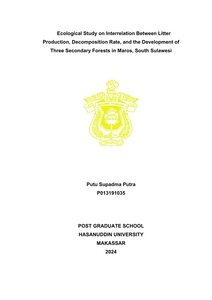Supadma Putra, Putu (2024) Ecological Study on Interrelation Between Litter Production, Decomposition Rate, and the Development of Three Secondary Forests in Maros, South Sulawesi. Disertasi thesis, Universitas Hasanuddin.
![[thumbnail of P013191035_disertasi_01-03-2024 Cover1.jpg]](/35528/1.hassmallThumbnailVersion/P013191035_disertasi_01-03-2024%20Cover1.jpg)

P013191035_disertasi_01-03-2024 Cover1.jpg
Download (216kB) | Preview
P013191035_disertasi_01-03-2024 bab1-2.pdf
Download (1MB)
P013191035_disertasi_01-03-2024.pdf
Restricted to Repository staff only
Download (4MB)
P013191035_disertasi_01-03-2024 Dapus.pdf
Download (1MB)
Abstract (Abstrak)
We studied differences in the seasonal patterns of litter production, decomposition rates and vegetation dynamics related to forest type, age, species composition and environmental factors in three tropical forests (Karst, Lowland and Pine forests) on Sulawesi Island, Indonesia. Permanent plots were established in each forest: 0.75 ha, 1 ha and 0.40 ha. Thirty-six litter traps, with a surface area of 1 m2 , were installed to collect litterfall. For the decomposition rate experiments, 60 containing tusam leaves and 60 containing ebony leaves were placed to observe the ex-situ decomposition process, 24 quadrats (1 m x 1 m) were set up on the forest ground to observe the in-situ decomposition process, and 600 jabon and 600 tusam wood planks were placed on the ground to observe the decomposition rate. The diversity of decomposing agents, soil properties, and chemical content of wood and leaf samples were analysed. We also observed the dynamics of forest vegetation. The results showed that the Karst forest, which has much lower total litter production than the Lowland and Pine forests, shows a higher k-value of the decomposition rate. The highest basal area growth rate was also found in the Karst forest with the lowest in the Pine forest, however, this does not align with the soil fertility indicator, which was higher in the Lowland forest than in the Karst forest and lowest in the Pine forest. Age and dominance of tree species could be the cause of this mismatch. This study explains that the rate of decomposition does not always have to be directly or inversely proportional to litter production. Depending on the combined influence of the intrinsic and extrinsic factors, the litter production and decomposition rates can vary between forest communities which in turn influences the development of forest communities.
| Item Type: | Thesis (Disertasi) |
|---|---|
| Subjects: | S Agriculture > S Agriculture (General) |
| Divisions (Program Studi): | Program Pascasarjana > Ilmu Pertanian |
| Depositing User: | - Andi Anna |
| Date Deposited: | 01 Aug 2024 07:03 |
| Last Modified: | 01 Aug 2024 07:03 |
| URI: | http://repository.unhas.ac.id:443/id/eprint/35528 |


